Solvent-Controlled Morphology of Ni-BTC and Ni-BDC Metal-Organic Frameworks for Supercapacitors
NIU Bai-TongXIA Wang-NanLAI Zhao-QinGUO Hong-Xu*,,CHEN Zhang-Xu
(1College of Chemistry,Chemical Engineering,and Environment,Minnan Normal University,Zhangzhou,Fujian 363000,China)(2Fujian Provincial University Key Laboratory of Ecological Environment and Information Atlas,Putian University,Putian,Fujian 351100,China)
Abstract:The performance of energy storage materials is substantially dependent on their nanostructures.Herein,Ni-1,3,5-benzenetricarboxylate(Ni-BTC)and Ni-1,4-benzoate(Ni-BDC)metal-organic frameworks with different morphologies were controllably synthesized using a facile solvothermal method by simply adjusting the solvent,including Ni-BTC blocks,nanospheres,and double-pyramid structures and Ni-BDC nanosheets,nanoflowers and blocks structures,and their electrochemical performance as supercapacitors was thoroughly investigated.Moreover,our study showed that the supercapacitor performance of the electrode materials obtained for Ni-BTC and Ni-BDC electrodes in pure N,N-dimethylformamide(DMF)solvent was better than those prepared with pure ethanol(EtOH)and DMF/EtOH(50∶50,V/V)as solvent.
Keywords:supercapacitor;morphology tuning;solvothermal method;metal-organic frameworks
0 Introduction
Nowadays,the shortage of nonrenewable energy and increased environmental problems caused by developing the economy have aroused massive researchers devoted to new energy storage devices exploration,particularly rechargeable ion batteries,electrochemical water splitting,and supercapacitors(SCs)[1].SCs,a novel form of energy storage device between capacitors and batteries,provide the benefits of extended cycle life,rapid charge and discharge,high power density,and minimal environmental impact[2].As a result,they are widely used in a variety of sectors,such as backup power systems,hybrid electric vehicles,portable electronic equipment,and information technology.
In recent years,metal-organic frameworks(MOFs)have been extensively developed as electrode materials for SCs[3-9].MOFs are composed of organic linkers and metal ions by strong chemical bonds[10].Owing to the diverse structure with large specific surface area and rich pore structure,MOFs are hot topics in novel functional materials,and they have aroused more and more concentration among plentiful researchers[11-15].Nevertheless,a large number of experiments indicate that the electrode materials can reach a high energy density depending not only on the composition but also on the shape and size[16].Various strategies have been discovered to control the morphologies of MOFs,such as altering the reaction temperature and time[17],tuning the proportion of metal ions[18],and adjusting the pH value[19].Then,the solvent-controlled morphology of MOFs with uniform shape and adjustable size is a convenient and feasible method to improve their electrochemical performance for supercapacitors[20].
Herein,three kinds of Ni-BTC materials with different shapes and stable configurations were synthesized from the 1,3,5-benzenetricarboxylate(BTC3-)ligand,namely,Ni-BTC blocks,nanospheres,and double-pyramid structures.Furthermore,three kinds of Ni-BDC materials with different shapes and stable configurations were synthesized from the 1,4-benzoate(BDC2-)ligand,namely,Ni-BDC nanosheets,nanoflowers,and block structures.This solvent-adjustment method by changing the solvent is simple and controllable.Experiments revealed that the solvent-controlled morphology of MOFs is a convenient and feasible method to improve the electrochemical performance of supercapacitors.
1 Experimental
1.1 Reagent and characterization
Unless otherwise specified,all chemical reagents used were of analytical grade and can be used without further purification.1,3,5-benzenetricarboxylic acid(H3BTC)and 1,4-dicarboxybenzene(H2BDC)were procured from Aladdin Chemistry Co.,Ltd(Shanghai,China).Ni(NO3)2·6H2O,ethanol(EtOH),andN,N-dimethylformamide(DMF)were procured from Xilong Chemical Reagent Co.Ltd(China).
The powder X-ray diffraction(XRD)was performed on a Rigaku D/MAX-RB X-ray Diffractometer(Japan)using CuKαradiation(λ=0.154 06 nm)at 40 kV and 40 mA,and the XRD patterns were recorded in a 2θrange from 5°to 60°.FT-IR was measured on a NICOLET iS 10IR(USA)Fourier transform infrared spectrometer.The morphologies of the MOFs were characterized on a Hitachi SU8010 field-emission scanning electron microscopy(SEM,Japan)and the operating voltage was 5 kV.A Belsorp-MAX(USA)fully automatic multi-station specific surface,micro,and mesoporous porosity analyzer was used to conduct the nitrogen adsorption-desorption isotherms.
1.2 Preparation of Ni-BTC MOF and Ni-BDC MOF materials
Briefly,the Ni-BTC MOFs were prepared through a simple solvothermal method.For the synthesis of Ni-BTCEtOH,Ni(NO3)2·6H2O(0.436 g,1.5 mmol)was added to 60 mL of absolute ethanol,followed by the addition of H3BTC(0.294 g,1.4 mmol).After being stirred for 30 min,the obtained homogeneous solution was transferred into a 100 mL autoclave with a Teflon lining and heated at 180℃for 12 h.After cooling to room temperature,the resultant green precipitate was collected by centrifugation,washed with DMF,ethanol,and deionized water several times,and then dried at 80℃for 12 h.Similarly,Ni-BTCDMFand Ni-BTCDMF/EtOHwere synthesized following the same procedures by using DMF and DMF/EtOH(50∶50,V/V)as the solvent,respectively.
The Ni-BDC MOFs were prepared through a simple solvothermal method.For the synthesis of Ni-BDCEtOH,Ni(NO3)2·6H2O(0.436 g,1.5 mmol)was added to 60 mL of absolute ethanol,followed by the addition of H2BDC(0.166 g,1.0 mmol).The same steps were taken to prepare Ni-BDCEtOH.Similarly,the Ni-BDCDMFand Ni-BDCDMF/EtOHwere synthesized following the same procedures by using DMF and DMF/EtOH(50∶50,V/V)as the solvent,respectively(Scheme 1).

Scheme 1 Schematic illustration describing the synthesis of Ni-BTC and Ni-BDC MOFs with various morphologies through a simple solvothermal method with DMF,DMF/EtOH(50:50,V/V),and EtOH as the solvent,respectively
1.3 Preparation of working electrode
The production of a working electrode was done utilizing a slurry-forging technique by smearing the sample over the nickel foam(NF,1 cm×1 cm).In this regard,active material(Ni-BTC or Ni-BDC),polyvinylidene fluoride(PVDF),as well as acetylene black were ground together in a mass ratio of 8∶1∶1,followed by the addition of ethanol into the powder to create slurry conditions.Subsequently,the slurry was evenly smeared over the NF and dried for 12 h at 60℃.Before being used in the electrochemical analysis,the dried NF was subjected to 10 MPa stress testing for about 30 s.
1.4 Electrochemical measurements
The electrochemical tests were performed at room temperature.The detection of all electrochemical performances was performed on a CS2350H electrochemical workstation(CorrTest Instruments,Wuhan,China).
In the supercapacitor test,the measurements were carried out in a standard three-electrode configuration by utilizing 3 mol·L-1KOH as the electrolyte,saturated calomel electrode(SCE)as the reference electrode,and platinum wire as the counter electrode.Electrochemical impedance spectroscopy(EIS)measurement was recorded in a range of 105to 0.01 Hz at opencircuit potential(OCP)by applying a perturbation signal of 10 mV.The specific capacitance of the supercapacitor was obtained by the following equation:Cs=IΔt/(mΔV),whereCs(F·g-1)denotes the specific capacitance,I(A)denotes the discharge current,Δt(s)denotes the discharge time,m(g)denotes the mass of active material,which is weighted separately,and ΔVdenotes the potential window.
2 Results and discussion
2.1 Structure and morphology analysis of Ni-BTC
The XRD patterns of Ni-BTCDMF,Ni-BTCDMF/EtOH,Ni-BTCEtOH,and the corresponding simulation,as shown in Fig.1a.The XRD pattern of Ni-BTCDMF/EtOHhad a large and wide characteristic peak at 8.9°,15.1°,17.5°,18.6°,and 27.1°,which confirms that it is an amorphous structure.From the XRD patterns of Ni-BTCDMFand Ni-BTCEtOH,it can be seen that the main sharp peaks at 15.1°,17.5°,18.6°,22.0°,27.1°,28.5°,and 35.8°,corresponding to the(202),(23),(301),(41),(35),(51),and(108)crystal planes,respectively,are similar to the standard diffraction pattern of Ni3(BTC)2(CCDC:274177)[21].The FT-IR spectra of Ni-BTCEtOHand H3BTC are illustrated in Fig.1b to thoroughly examine the as-synthesized Ni-BTCEtOHchemical structure.According to the comparison results,nearly all the FT-IR bands were in close agreement with those of Ni-BTC earlier reported[22].The typical bands associated with the non-ionized carboxyl groups in BTC3-(i.e.,νOH=3 088 cm-1,νC=O=1 716 cm-1,andδC=O=536 cm-1)were not observed in Ni-BTCEtOH[23].Furthermore,the peaks at 1 622 and 1 556 cm-1are attributed to the asymmetric stretching vibrations of—COO-coordinated to the Ni2+ion in a bidentate mode,while the peaks at 1 435 and 1 368 cm-1are due to symmetric stretching vibrations[24].Meanwhile,the peaks between 880 and 680 cm-1indicate that H3BTC is experiencing bending vibrations from the benzene plane[25].Moreover,the 3 500-3 200 cm-1band corresponds to hydrogen bond H2O molecules.A stable Ni-BTC structure is formed by fixing scattered Ni active sites via covalent bonds in these chemical structures[26].

Fig.1 (a)XRD patterns of Ni-BTCDMF,Ni-BTCDMF/EtOH,Ni-BTCEtOHand the corresponding simulation;(b)FT-IR spectra of Ni-BTCEtOHand H3BTC
The SEM images of three Ni-BTC indicate that they were completely different in morphology and size.When only DMF was used as the solvent,Ni-BTCDMFdisplayed a block morphology with a particle size of 700-800 μm(Fig.2a,2b).After adding EtOH into DMF(50∶50,V/V),Ni-BTCDMF/EtOHdisplayed a spherical morphology with a particle size of 3-5 μm(Fig.2c,2d).Besides,the surface of Ni-BTCDMF/EtOHspheres was smooth.Interestingly,when EtOH completely replaced DMF as the solvent,the obtained Ni-BTCEtOHshowed a double-pyramid structure(Fig.2e,2f)with a particle size of 300-400 μm.
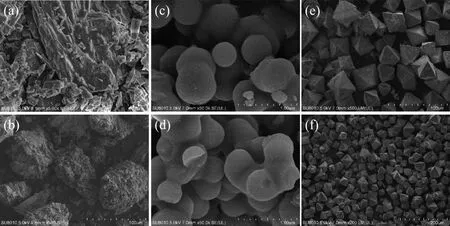
Fig.2 (a)SEM images of(a,b)Ni-BTCDMF,(c,d)Ni-BTCDMF/EtOH,and(e,f)Ni-BTCEtOH
Fig.3a shows the nitrogen adsorption-desorption isotherms of Ni-BTCDMF,Ni-BTCDMF/EtOH,and Ni-BTCEtOHmeasured at 77 K.The N2adsorption-desorption isotherm of Ni-BTC was type Ⅰ(H2)hysteresis loop,which is the principal characteristic of solids with micropores[27-28].The Brunauer-Emmett-Teller(BET)specific surface areas(SBET)of Ni-BTCDMF,Ni-BTCDMF/EtOH,and Ni-BTCEtOHwere determined to be 596,694,and 736 m2·g-1,respectively.From the pore size distribution curve in Fig.3b,it can be seen that the pore sizes of Ni-BTCDMF,Ni-BTCDMF/EtOH,and Ni-BTCEtOHwere mostly smaller than 5 nm.This indicates that it mainly has two kinds of pore sizes,micropores,and mesopores,which provide a channel for the transport of ions.

Fig.3 Nitrogen adsorption-desorption isotherms and(b)pore size distribution curves of Ni-BTCDMF,Ni-BTCDMF/EtOH,and Ni-BTCEtOH
2.2 Structure and morphology analysis of Ni-BDC
Fig.4a shows the XRD patterns of Ni-BDCDMF,Ni-BDCDMF/EtOH,and Ni-BDCEtOH,which revealed good correspondence with[Ni3(OH)2(C8H4O4)2(H2O)4]·2H2O(CCDC:638866)reported in a previous article[29].From the XRD patterns of Ni-BDC,it can be seen that the major diffraction peaks were at 9.3°,11.9°,12.2°,15.6°,18.4°,18.7°,23.8°,28.1°,and 29.3°,corresponding to the(100),(010),(10),(10),(20),(200),(020),(21),and(01)crystal planes,respectively.XRD results show that the synthesized products had a good crystal structure and similar structural characteristics.The FT-IR spectra of Ni-BDCDMF,Ni-BDCDMF/EtOH,and Ni-BDCEtOHare shown in Fig.4b.The peaks at 550 cm-1are attributed to O—Ni—O vibrations[30].The peaks at 820 and 740 cm-1are characteristic of the paraaromatic C—H stretching bands.The strong bands at 1 560 and 1 370 cm-1are attributed to the asymmetric and symmetric stretching modes of the coordinated—COO-groups,respectively[31].Meanwhile,the peaks at 3 418 cm-1is corresponding to stretching vibrations of the H2O molecules[32].These results all are in good agreement with the XRD result,and further confirm that the synthesized Ni-BDC MOF is a kind of nickel hydroxyl-terephthalate-based compound[33].
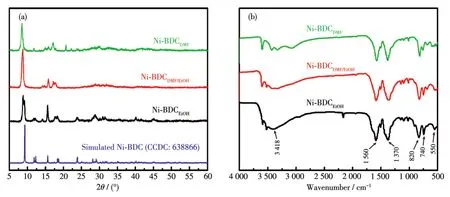
Fig.4 (a)XRD patterns of Ni-BDCDMF,Ni-BDCDMF/EtOH,Ni-BDCEtOHand the corresponding simulation;(b)FT-IR spectra of Ni-BDCDMF,Ni-BDCDMF/EtOH,and Ni-BDCEtOH
The morphologies of Ni-BDCDMF,Ni-BDCDMF/EtOH,and Ni-BDCEtOHwere investigated by SEM.When only DMF was used as the solvent,Ni-BDCDMFdisplayed a nanosheet morphology with a particle size of 100-150 μm(Fig.5a,5b).After adding EtOH into DMF(50∶50,V/V),Ni-BDCDMF/EtOHdisplayed a nanoflowers morphology with a particle size of 50-80 μm(Fig.5c,5d).The flower-like structure was composed of 2D nanosheets assembled by disordered alignment[34].Interestingly,when EtOH completely replaced DMF as the solvent,the obtained Ni-BDCEtOHshowed an irregular bulk structure(Fig.5e,5f).
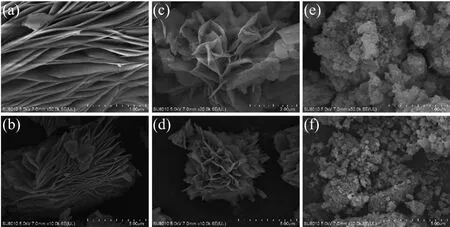
Fig.5 SEM images of(a,b)Ni-BDCDMF,(c,d)Ni-BDCDMF/EtOH,and(e,f)Ni-BDCEtOH
Fig.6a shows the nitrogen adsorption-desorption isotherms of Ni-BDCDMF,Ni-BDCDMF/EtOH,and Ni-BDCEtOHmeasured at 77 K.The nitrogen adsorption-desorption isotherm of Ni-BDC is type Ⅱ(H2)hysteresis loop,which is the principal characteristic of solids with micropores.TheSBETvalues of Ni-BDCDMF,Ni-BDCDMF/EtOH,and Ni-BDCEtOHwere determined to be 682,565,and 750 m2·g-1,respectively.From the pore size distribution curves in Fig.6b,it can be seen that the pore sizes of the samples were in a range of 1.6-2.5 nm,which shows that it has a uniform mesoporosity providing a channel for ion transmission.
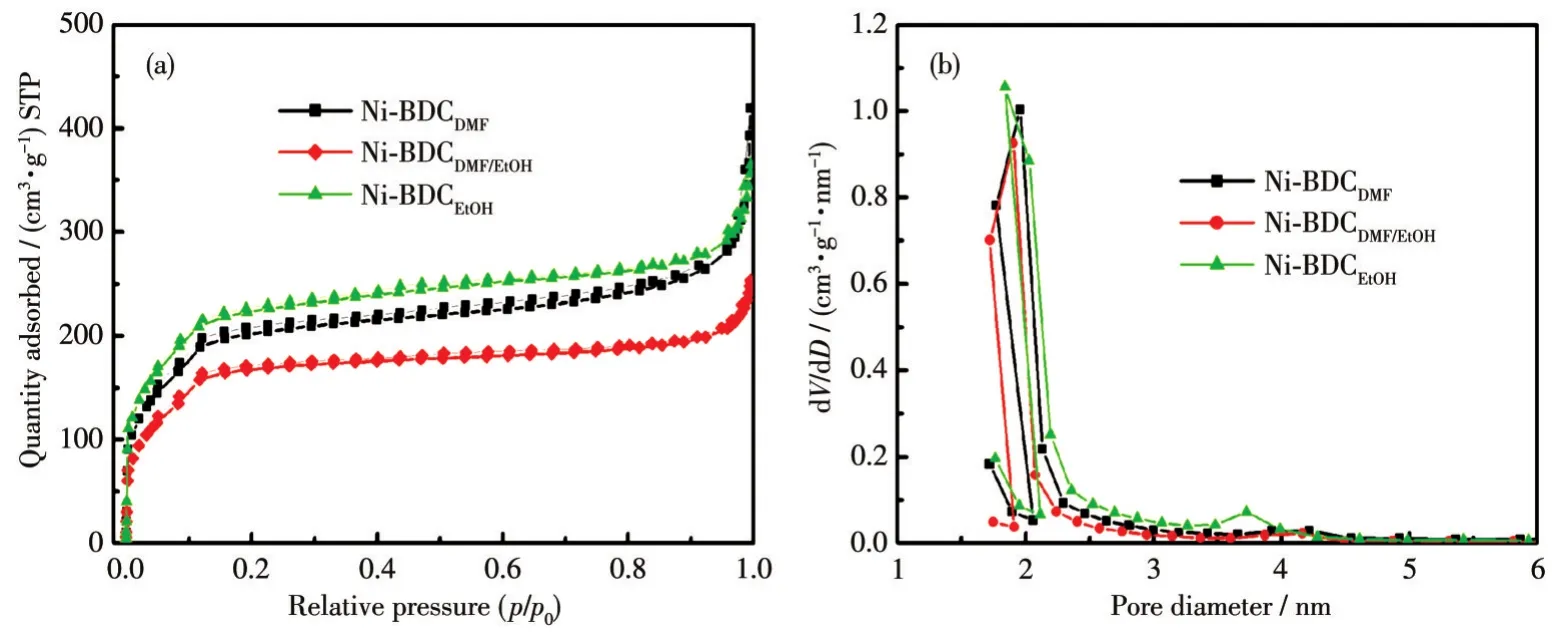
Fig.6 (a)Nitrogen adsorption-desorption isotherms and(b)pore size distribution curves of Ni-BDCDMF,Ni-BDCDMF/EtOH,and Ni-BDCEtOH
2.3 Supercapacitor performance of Ni-BTC
To investigate the electrochemical performance for capacitive energy storage,as-prepared Ni-BTC samples were tested in a three-electrode configuration in a 3 mol·L-1KOH aqueous electrolyte.The typical cyclic voltammetry(CV)curves of Ni-BTCDMFare shown in Fig.7a.The CV behavior of Ni-BTC is similar to that of the reported Ni-based MOF material tested in alkaline electrolytes.The charge-storage mechanism may be probably explained by the following redox reactions[35-36]:
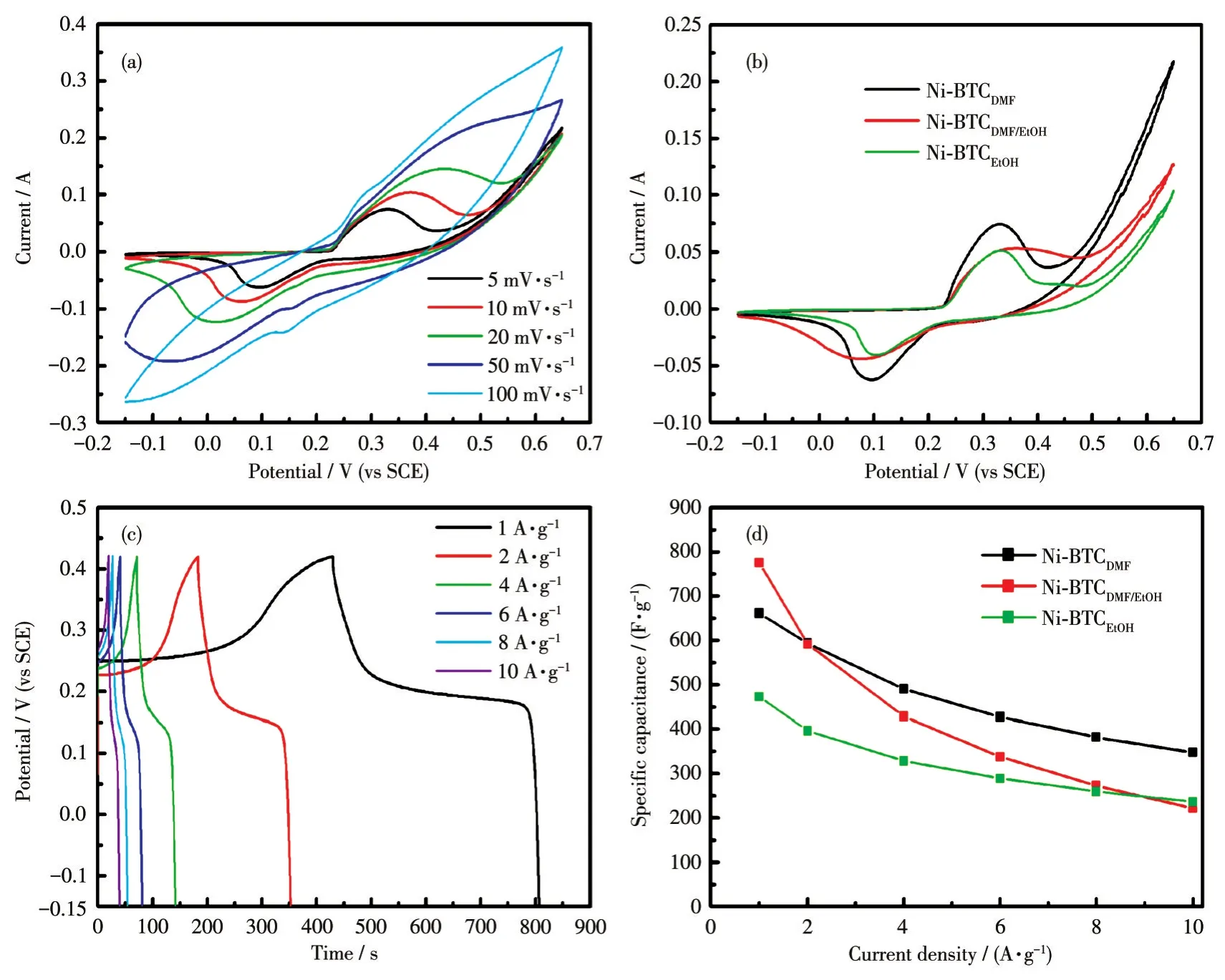
Fig.7 (a)CV curves of the Ni-BTCDMFelectrode at different scan rates;(b)CV curves of as-prepared Ni-BTC electrodes at a scan rate of 5 mV·s-1;(c)GCD curves of the Ni-BTCDMFelectrode at different current densities;(d)Specific capacitances of as-prepared Ni-BTC electrodes at different current densities

The CV curves of the Ni-BTCDMF,Ni-BTCDMF/EtOH,and Ni-BTCEtOHelectrodes at a constant scan rate of 5 mV·s-1are shown in Fig.7b.All the electrodes exhibited a nonstandard rectangular shape with obvious redox peaks,suggesting typical pseudocapacitance performance.Fig.7c shows the galvanostatic charge-discharge(GCD)curves of Ni-BTCDMFcomposites at current densities of 1,2,4,6,8,and 10 A·g-1.The specific capacitances were 661.0,593.7,490.1,427.0,381.8,and 347.4 F·g-1,respectively.The specific capacitances calculated from the discharge curves are plotted in Fig.7d.The Ni-BTCDMFelectrode still retained a high specific capacitance of 347.4 F·g-1at 10 A·g-1,which was about 52.5%of the value of capacitance at 1 A·g-1,indicating the excellent rate capability.
EIS was used to investigate the different materials' electroconductivity.The circle radius corresponding to Ni-BTCEtOHand Ni-BTCDMFin the high-frequency region was smaller,which means that they have a smaller charge transfer impedance,as illustrated in Fig.8a(the inset is an enlarged version of the highfrequency region).Table S1(Supporting information)lists the fitting values of equivalent circuit elements.It is noteworthy that Ni-BTCDMFrevealed a lower internal resistance than that of Ni-BTCDMF/EtOH(0.50 Ω)and Ni-BTCEtOH(0.47 Ω)obtained from the intercept of the Nyquist plots with the real axis,manifesting optimized electrode structures and interfacial connections within Ni-BTCEtOHelectrode.The corresponding equivalent electrical circuit for the Ni-BTCDMFelectrode is displayed in Fig.8b.In the equivalent circuit,Rsrepresents the internal resistance(ca.0.45 Ω),including the solution resistance,the active material(Ni-BDCDMF)intrinsic resistance,and the contact resistance between the active material and the current collector[37];Rctis the charge transfer resistance(ca.0.87 Ω),CPE is the constant phase element andWois the Warburg resistance[38].

Fig.8 (a)Nyquist plots of as-prepared Ni-BTC electrodes in 3 mol·L-1KOH electrolyte;(b)Equivalent electrical circuit for the Ni-BTCDMFelectrode
The cycling stability of the Ni-BTCDMF,Ni-BTCDMF/EtOH,and Ni-BTCEtOHelectrodes was tested by GCD at 4 A·g-1,as shown in Fig.9.When the solvent was pure DMF,the specific capacitance of the Ni-BTCDMFelectrode decreased from the initial 386.0 to 273.7 F·g-1after 2 000 cycles,and the capacitance retention rate was 70.9%.The specific capacitance of the Ni-BTCDMF/EtOHelectrode decreased from the initial 371.9 to 161.4 F·g-1,and the capacitance retention rate was only 43.4%.This may be related to the changes in the microstructure of the nickel-based MOF during charging and discharging,such as structural collapse.When the solvent was pure EtOH,the specific capacitance of the Ni-BTCEtOHelectrode decreased from the initial 301.8 to 280.7 F·g-1,and the capacitance retention rate was 93.0%.Although the specific capacitance of the Ni-BTCEtOHelectrode was smaller than that of the Ni-BTCDMFelectrode,its cycle performance was better than that of the Ni-BTCDMFelectrode.

Fig.9 Cycling stability of as-prepared Ni-BTC electrodes at 4 A·g-1
2.4 Supercapacitor performance of Ni-BDC
To study the electrochemical property,the CV behaviors of as-prepared MOF electrodes were investigated at different scan rates(5,10,20,50,100 mV·s-1)in 3 mol·L-1KOH electrolytes using a three-electrodes test system.Fig.10a presents the CV curves of the Ni-BDCDMFelectrode at different scan rates in a potential range of 0-0.65 V(vs SCE).The CV behavior of Ni-BDC is similar to that of the reported Ni-based MOF material tested in alkaline electrolytes.This process might be represented by the following electrontransfer equation[33,39]:
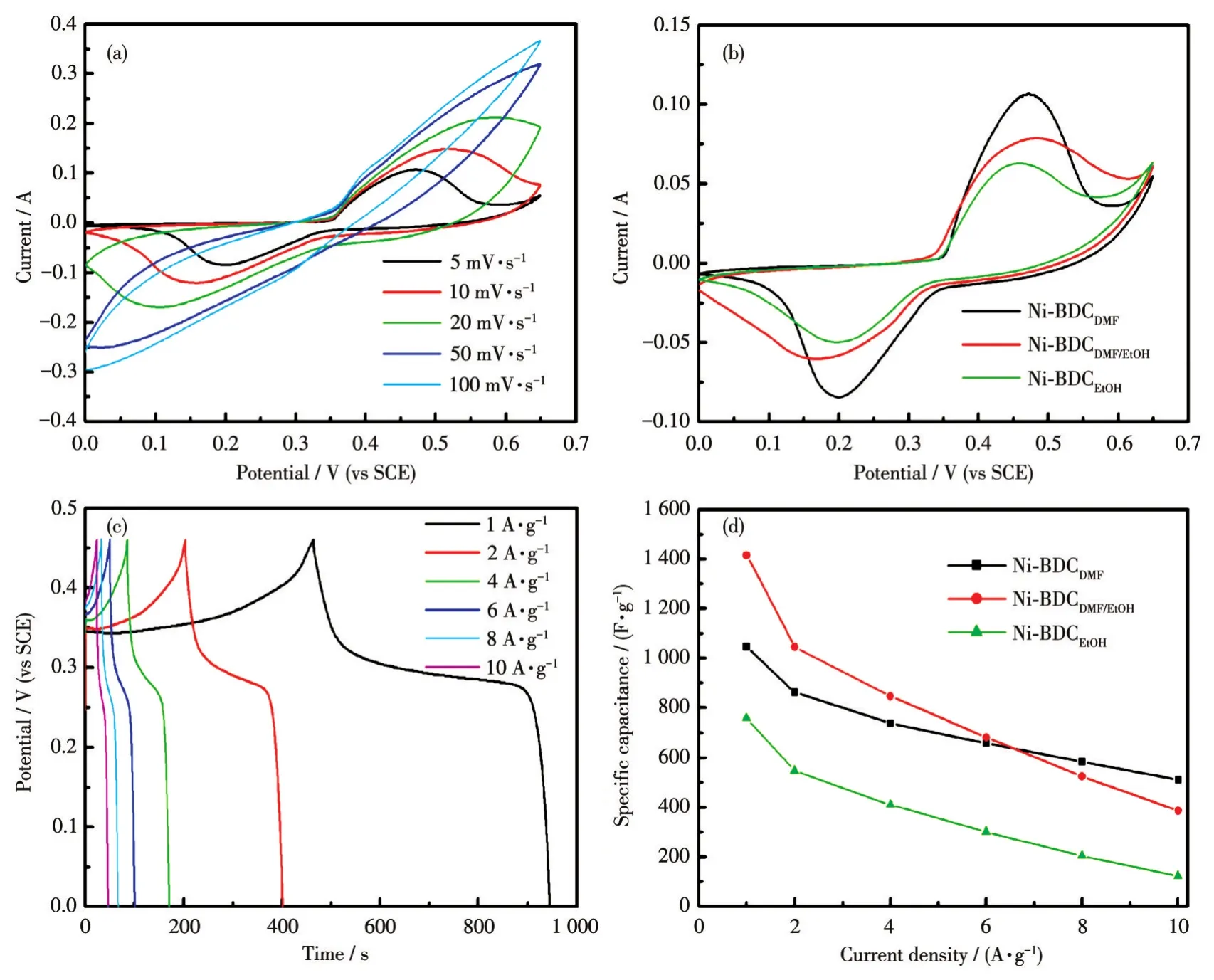
Fig.10 (a)CV curves of the Ni-BDCDMFelectrode at different scan rates;(b)CV curves of as-prepared Ni-BDC electrodes at a scan rate of 5 mV·s-1;(c)GCD curves of the Ni-BDCDMFelectrode at different current densities;(d)Specific capacitances of as-prepared Ni-BDC electrodes at different current densities

The CV curves of the Ni-BDCDMF,Ni-BDCDMF/EtOH,and Ni-BDCEtOHelectrodes at a constant scan rate of 5 mV·s-1are exhibited in Fig.10b.A couple of distinct redox peaks were observable,indicating that the typical pseudo-capacitive behavior caused by surface Faradic redox reactions corresponds to the reversible intercalation and deintercalation of OH-ions.Fig.10c shows the GCD curves of the Ni-BDCDMFelectrode within a potential window of 0-0.46 V(vs SCE)at different current densities.The corresponding specific capacitance of the Ni-BDCDMFelectrode at 1 A·g-1was calculated to be 1 044.9 F·g-1.Fig.10d shows the specific capacitance as a function of discharge current density for the Ni-BDCDMF,Ni-BDCDMF/EtOH,and Ni-BDCEtOHelectrodes.The Ni-BDCDMFelectrode still retained a high specific capacitance of 509.4 F·g-1at 10 A·g-1,which was about 48.8%of the capacitance at 1 A·g-1,indicating the excellent rate capability.
The electroconductivity of the Ni-BDCDMF,Ni-BDCDMF/EtOH,and Ni-BDCEtOHelectrodes was also investigated by EIS.As shown in Fig.11(the bottom inset shows an enlarged version of the high-frequency region),the radius of the circle corresponding to Ni-BDCDMFin the high-frequency region was smaller,which means that it has a smaller charge transfer impedance.The corresponding equivalent electrical circuit is displayed in the top inset of Fig.11.In the equivalent circuit for Ni-BDCDMF,Rswasca.0.36 Ω andRctwasca.0.71 Ω(Table S2).At the same time,it also shows that the Ni-BDCDMFelectrode is a host material for high electrolyte access,penetration,and ion diffusion,which is conducive to the rapid storage and release of energy and has good electrical conductivity.
The cycling stability of the Ni-BDCDMF,Ni-BDCDMF/EtOH,and Ni-BDCEtOHelectrodes was tested by GCD at 4 A·g-1,as shown in Fig.12.The specific capacitance of the Ni-BDCDMFelectrode decreased from the initial 713.0 to 617.4 F·g-1after 2 000 cycles,and the capacitance retention rate was 85.9%.The specific capacitance of the Ni-BDCDMF/EtOHelectrode decreased from the initial 765.2 to 69.6 F·g-1,and the capacitance retention rate was only 9.1%.It shows that the stability of Ni-BDCDMF/EtOHwas very poor,which may be due to the collapse of the structure of Ni-based MOF during charging and discharging.In addition,the FT-IR spectrum after cycling is shown in Fig.S1,which further proves that poor cycling is caused by the structural collapse.The specific capacitance of the Ni-BDCEtOHelectrode decreased from the initial 434.8 to 356.5 F·g-1,and the capacitance retention rate was 82.0%.
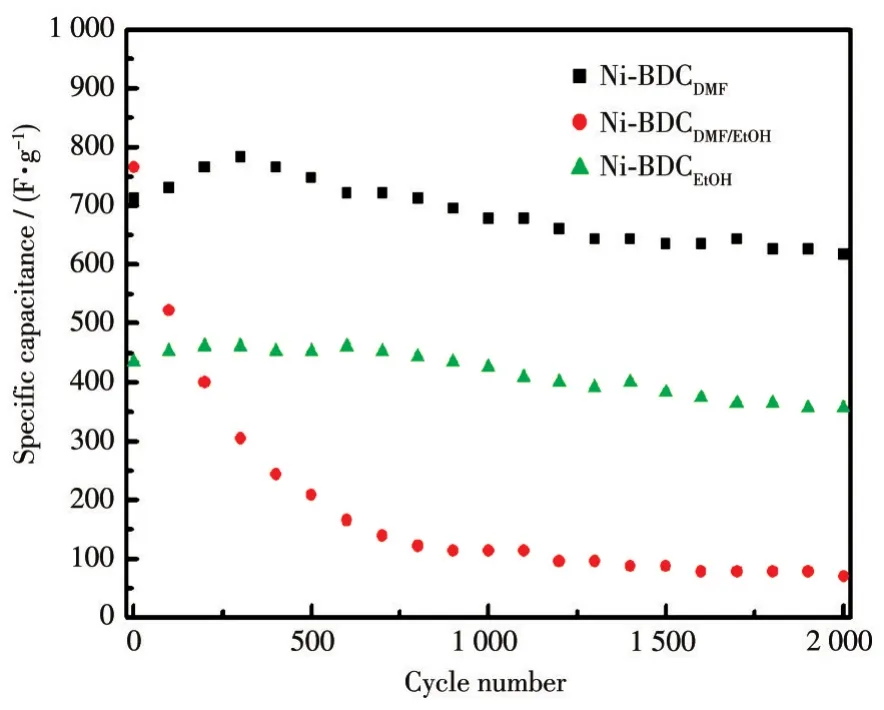
Fig.12 Cycling stability of as-prepared Ni-BDC electrodes at 4 A·g-1
From the above results and discussion,the solvent has a significant effect on the electrochemical properties of the materials.The possible formation mechanism of Ni-BTCDMFor Ni-BDCDMFcan be narrated in terms as follows:DMF and EtOH have different viscosities,saturated vapor pressures,and polarities,which can affect the diffusion rate,supersaturation,nucleation,and crystal growth to some extent[40].When using DMF alone as the solvent,the deprotonation of H3BTC was fast and produced a crystal aggregate.H2BDC,which was stripped of protons,coordinated with free metal cations(Ni2+).The lamellar MOF structure was formed by confining the growth of the lamellar material to a 2D space because the proton and the metal cation leave simultaneously in the ion domain[34].Ni-BDCDMFis made up of many-layered micro-sheets,which means that there are thousands of nanochannels in the hierarchical architecture.What is more,thousands of nanochannels might largely improve the diffusion of ions and electrolytes,and the microbundle might offer a stable skeleton for ion intercalation-extraction.In short,the solvent effect leads to different morphologies of the products,which in turn affects the stability of their electrical storage properties.Moreover,the comparison with the reports in the literature is shown in Table 1.

Table 1 Specific capacitances of some MOF-based materials
3 Conclusions
In conclusion,three kinds of Ni-BTC materials with different shapes and stable configurations were synthesized from the 1,3,5-benzenetricarboxylate ligand,namely Ni-BTC blocks,nanospheres,and double-pyramid structures.Furthermore,three kinds of Ni-BDC materials with different shapes and stable configurations were synthesized from the 1,4-benzoate ligand,namely Ni-BDC nanosheets,nanoflowers,and block structures.This solvent-adjustment method by changing the solvent is simple and controllable.The experimental results reveal that controlling the morphology of MOFs by the solvent is a convenient and feasible method to improve the electrochemical performance of supercapacitors.
Supporting information is available at http://www.wjhxxb.cn
- 无机化学学报的其它文章
- Synthesis,Structure,and Properties of Rare-Earth Complexes Based on Pyridine Dicarboxylic Acid Ligands
- Facile Synthesis of Si@LiAlO2 Nanocomposites as Anode for Lithium-Ion Battery
- 基于多金属氧酸盐和多壁碳纳米管的双酚A电化学传感器的构建与性质
- A Fast-Responsive Mitochondria-Targeting Fluorescent Probe Detecting Hypochlorite in Living Cells and Zebrafish
- A Complex of Silver(Ⅰ)with N-O Chelating Agent and Phosphine Ligand:Design,Structures,and Biological Activity
- Synthesis,Structure,Magnetic,and Fluorescent Sensing Properties of Cobalt(Ⅱ)Coordination Polymer Based on 1-(3,5-Dicarboxybenzyl)-1H-pyrazole-3,5-dicarboxylic Acid

